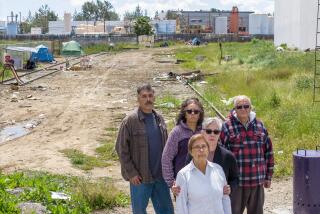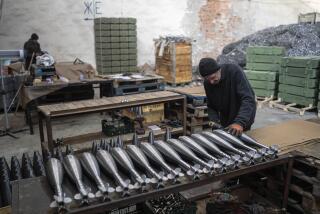Verification of Gas Plant a Murky Task : Global Intelligence Effort Used to Build Case Against Libya
- Share via
WASHINGTON — In contrast to facilities producing nuclear weapons and ballistic missiles, facilities that make chemical weapons are becoming increasingly hard to distinguish from ordinary industrial plants turning out pesticides and medicines, arms control analysts say.
The murky problem of verification--the difficulty of telling a benign chemical plant from one manufacturing chemical weapons--is a major barrier to a treaty to control the increasingly worrisome proliferation of chemical weapons in developing countries.
According to a variety of government and industry analysts, however, there are few doubts, at least among American experts, about the purpose of the large industrial plant in the Libyan desert at Rabta, 40 miles southwest of Tripoli, that has become a new object of contention between the United States and Libyan leader Col. Moammar Kadafi.
The Libyans insist that the plant, known as Pharma-150, is being built to manufacture pharmaceuticals. U.S. officials say that it is on the verge of manufacturing mustard gas and possibly sarin, a far more lethal nerve gas.
This concern, officials say, is based in part on global intelligence efforts that monitor exports and imports of critical materials for such plants, including glass-lined piping and unusual corrosion-resistant steel alloys. It is a task, they note, that is far better suited to human intelligence-gathering than satellite photography, although satellites are believed to have been monitoring construction and other aspects of the Libyan project.
Surrounded by Missiles
While U.S. officials have been reluctant to disclose detailed intelligence that they say supports this contention, they note that the Libyan plant is unusual in at least one respect: It is surrounded by anti-aircraft missile emplacements.
“A chemical manufacturing plant is a chemical manufacturing plant. It can manufacture all kinds of chemicals,” William F. Burns, director of the Arms Control and Disarmament Agency, acknowledged Wednesday at a breakfast meeting with reporters.
But if Pharma-150 is what Libya insists it is, Burns added, it would be “the most heavily defended pharmaceutical plant in the world.”
Kyle Olson, an arms control analyst with the Chemical Manufacturers’ Assn., reinforces the point, noting that “most countries don’t view aspirin as a target of opportunity” in need of such costly protection.
“You also have to ask if a pharmaceutical plant makes any economic sense,” Olson observed. “For Libya, does it make sense to build a pharmaceutical plant out in the east end of nowhere, to wade into an oversaturated world market?”
As further evidence of its weapons mission, according to other sources familiar with the Libyan facility, U.S. intelligence analysts have concluded that Pharma-150 contains metal-machining equipment obtained from Japanese firms for producing artillery shells or gas canisters for use in other munitions. These sources said the United States has obtained corroborating information from foreign technicians who have worked at the Libyan plant.
U.S. intelligence agencies also are believed to monitor shipments and commercial transactions with national security implications, using communications intercepts involving Libya and an array of other sources.
U.S. sources said this week that Libya has been moving equipment associated with weapons production away from the chemical plant in an effort to protect it from retaliation. The officials would not say how they knew of the Libyan activity at the plant, which was described as taking place only within the last few days.
Although there appear to be few doubts among U.S. analysts about the nature of the Libyan plant, the broader problem of telling innocent chemical plants from weapons plants is one of the knottiest on the arms control agenda of industrial nations.
Satellite photography, for example, is said to be less useful than when used to pick out ballistic missile facilities and nuclear weapons production plants.
A decade ago, chemical weapons plants had a number of distinguishing features that would show up in photographs, such as tall ventilator stacks and large air filtration systems. Now, however, such signs are less-certain indicators of weapons activity.
Strict Standards
As industry has adapted to increasingly strict environmental and occupational health standards, ordinary chemical plants have acquired these and other exotic features, such as steel piping and reaction vessels lined with glass and double- or triple-sealed pumps to guard against leaks.
With changing industrial standards, the task of discerning the purpose of a suspicious plant, an Administration expert said, begins with looking at the collective implications of a package of “indicators,” which in turn requires knowing how a plant is built, what key materials are involved and the degree of precautions taken to protect workers from toxic substances.
The toxicity of chemical weapons such as mustard gas and nerve agents is 10 times to 1,000 times greater than pesticides and requires a corresponding degree of built-in protection.
“If they want their people to last more than a couple days on the job, they’re going to have to isolate piping and valves, and men are going to have to go around in peculiar rubber suits,” said this analyst, who asked not to be identified by name or agency.
Although similar precautions are taken in modern pesticide plants, he noted, “there is a discernible difference” in facilities designed to produce chemical weapons.
A further sign of intent to produce chemical weapons, at least in developing countries, is the importation of exotic anti-corrosion alloys. When sarin, a fluoride-based nerve gas, is manufactured, even glass-lined piping dissolves.
One indicator of an interest in making sarin, officials said, is the import of high-nickel alloys. They declined to say, however, whether Libya was known to have imported such alloys for its plant.
The scale of pharmaceutical plants is also much smaller than chemical weapons plants, which have to produce larger doses.
While tiny amounts of toxins can be lethal in confined spaces, the military use of chemical weapons usually requires large quantities of the poisons.
Weapons plants, government analysts said, also tend to lack supplies of steel drums and other forms of packaging for their product.
Times staff writer Norman Kempster contributed to this story.
More to Read
Sign up for Essential California
The most important California stories and recommendations in your inbox every morning.
You may occasionally receive promotional content from the Los Angeles Times.













